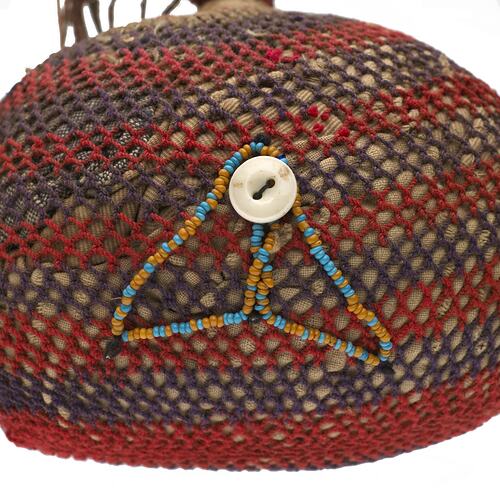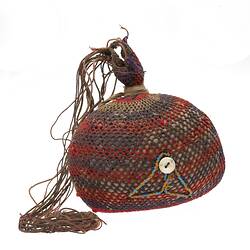Summary
Small string bags known as biting bags or power bags are known by the different groups in western Arnhem Land as baldarrk, marlakka and balluk. These are filled with feathers and secured at the top forming a ball shape, and were worn around the neck by initiated men, who held it in the mouth during fighting. The bags are believed to contain small stones or other objects that give power to the combatant, ensuring their success in battles that usually involve wielding large heavy wooden clubs. Stencilled images of biting bags have been identified in recent years in a ancient rock art site of Djomdjayi in the Mok clan estate on the upper Liverpool River in western Arnhem Land. In 1912, Baldwin Spencer noted that during his visit at Oenpelli, every Gaagudju man wore one of these power bags.
Local Name
baldark or marlakka
Physical Description
A biting bag made of string and filled with feathers and tied at the top. It has horizontal bands of red, blue and uncoloured cotton thread and coloured glass beads and a white button are stitched on the outside. A multistrand handle of vegetable fibre string is attached.
Significance
This biting bag is unusually made from European thread rather than the usual string made from banyan or other vegetable fibre. In 2004 Kunwinjku elders visited the museum said it could have belonged to Gaagudju or Kunwinjku people who were camped at Oenpelli during Paddy Cahill's time there. They said this one was called baldarrk and also noted the use of 'Balanda colours'. This relates to the use of the red and blue thread to make the bag, and Garnbaladj Nabegeo commented that the button and glass beads were most likely added 'to make pretty to sell'. She further noted its ceremonial association saying it was 'used at ceremony [to] make a young man'. The late Thompson Yulidjirri commented that his 'mother's sister used [to make] this one. She didn't talk English.'
More Information
-
Object/Medium
Bag
-
Maker
-
Cultural Groups
-
Locality
Oenpelli, Western Arnhem Land, Northern Territory, Australia
-
Date Produced
-
Collector
-
Date Collected
-
Object Measurements
400 mm (Length), 130 mm (Width), 100 mm (Height)
-
Keywords
-
References
[Book] Hamby, Mary L. 2005. Twined together: Kunmadj Njalehnjaleken.
-
Collection Names
-
Type of item
-
Discipline
-
Category
-
Collecting Areas
Australian Indigenous - Northern Australia and Queensland and Torres Strait Islands


